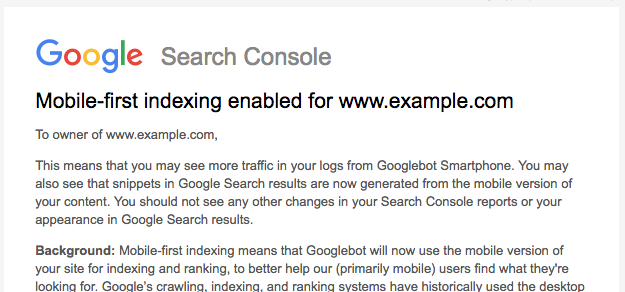Google announced yesterday that you have now begun migrating websites to their mobile first index. But what’s actually this and what does it mean to you who own a website? In this article we will give you the answers!
Well this is not a latest update happened last midnight. Google launches Mobile first indexing couple of months ago. It focused USA first and then EU. But, Now Since couple of days we are receiving mobile first activation messages in search console for Australian clients.
Now, You know why we are writing about mobile first indexing.
It’s probably not the first time you’ve heard of Google’s mobile first index. By November 2016 , it was announced that most searches were made from a mobile device. Because of this, they also began testing and experimenting to ultimately make their index “mobile first”, which was implemented yesterday. Let’s explain it a little more!

What is mobile first indexing?
In the blog post where you announce that you switch to mobile-first indexing, you can read the following:
“Today, we announce that after one and a half years of careful experimentation and testing, we have begun migrating websites that follow the best methods for mobile first indexing.”
To give you a better picture of it all, Google’s indexing and ranking systems are always based on website’s desktop version.
As more and more users began to abandon the computers and instead use their mobile phones, problems were caused when websites were not mobile. In other words, a bad user experience was created for the majority of users.
To get rid of this and to provide the majority of users with the best possible results, you have now switched to using websites’ mobile versions for indexing and ranking.
However, this does not mean that the desktop version of your site is completely out of the image. One will still use one and the same index, which means, for example, that sites that do not have a mobile-adapted version can instead get the desktop version indexed. However, the lack of a mobile-friendly site may affect your SERP: rankings.
You can also see the word “mobile-first” as a reference to the fact that the mobile version of your website will now be seen as the primary version . Also, think it’s called mobile-first and not mobile-only. If you already have a responsive website where all content is customisable for mobile devices, this update should not cause any negative changes to your placements.
What should I do?
So far, it’s no use to panic, given that Google says in its statement that so far, it’s only begun to migrate those websites that follow its mobile-first indexing guidelines.
They will successfully announce the sites that are moved to the new index through Search Console. This will look like this:

Having said that, however, it is high time to build a responsive site if you have not already. Studies have shown that:
- 61% of mobile users would leave a website if they did not find what they were looking for.
- 79% of mobile users who do not like what they find on a site will leave and move on to another site in search results.
- 50% of mobile users will not use a website if it is not mobile, even if they like the company itself.
Below are additional steps you can take to prepare you for the move to Google’s mobile first index:
Think like Google – Looking generally, you tend to be quite good at being open with the big changes that happen, such as the transition to the new index. A good tip is to read through Google’s blog posts to get additional background facts and understanding of new updates. It is not enough to just read these posts, but you also have to take the facts and start thinking like Google!
Optimize Content – If you do not have the time or resources to invest in a responsive website at the moment, you can at least ensure that content is the same on mobile as on the site. Thus, it is not a good idea to scale or hide content on the mobile version.
Optimizing the technical details – As we talked a lot about in previous articles, they are also important to think about the technical details. Use structured data and make sure that internal links work. Do not forget to do redirects, also known as 301 redirects, on those pages that are not working.
Take advantage of Google’s testing tools – Something we also talked a lot about in previous articles is daring to use the various test tools available. For example, it might be a good idea to check how mobile-friendly your site is using their mobile friendliness test , how well your data is structured with the structured data testing tool , and check the speed of your site using PageSpeed Insights Tool .
Search Console Verification – If you have only verified the desktop version of your site in Search Console, you should also verify the mobile version.
Summary
To merge the bag, we thought to summarize the key points to take part in Google’s mobile first index:
- You still have one and the same index. The difference now is that the mobile version of your site will be the primary version that is indexed and determines your ranking.
- Google will send you a message via Search Console when your site has been migrated to its mobile index. So far, you’re just trying to move across the websites that follow its mobile-first indexing guidelines and seem “ready” for the move.
- If you only have a desktop version of your site, it will still be indexed.
- If you are monitoring log files, you will notice that indexing will primarily happen from Googlebots for smartphones.
- If you have a mobile-adapted page and an AMP page, Google will prefer to index the mobile-page in front of AMP.


